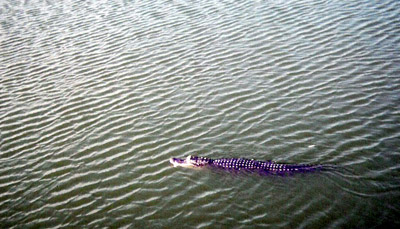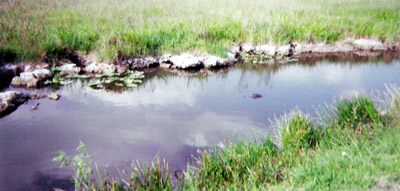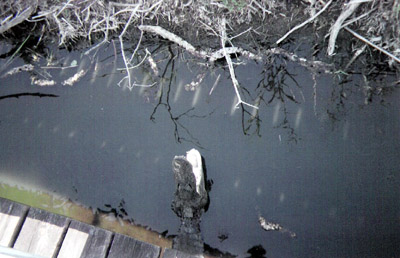
Threats to Everglades continue to increase
FLORIDA CITY, Fla.— Underneath the boardwalk, an alligator looks up at family staring down at it, lifts its head out of the water, opens its mouth wide and lets out a growling roar, before it descends back into its swampy abode.
This is the Everglades National Park. It is in this unique dry / wet habitat that large alligators, crocodiles, manatees, turtles, snakes, panthers, exotic birds and colorful insects coexist.
However, the threat of extinction of some of these species is real. The loss of habitat, alteration of water flow, pollution and human intervention are disrupting this peaceful nestling place.
The Everglades National Park, officially established in 1947, was the first national park preserved primarily for its abundance and variety of life, rather than for scenic or historic purposes. It is no wonder, then, that the park officials at the Everglades are adamantly informing the public about the future of its 14 endangered species, now being threatened by extinction.
 |
An alligator swims in the Everglades (Photo by Danielle Cohn). |
The endangered species in the park are: the American crocodile, green turtle, Atlantic ridley turtle, Atlantic hawksbill turtle, Atlantic leatherback turtle, Cape Sable seaside sparrow, snail kite (bird), wood stork, West Indian manatee, Florida panther, Key Largo wood rat, Key Largo cotton mouse, red-cockaded woodpecker and the Schaus swallowtail butterfly.
The development of South Florida and the growing number of people moving into the area has had an increasing detrimental impact on the habitats and lives of these species, notably the turtles, manatees, crocodiles, panthers and wood storks.
“There are three main reasons why the sea turtles have become endangered,” said Alan Scott, district interpretive park ranger at the Everglades National Park. “One, their eggs are taken as food and therefore they can’t reproduce, the population diminishes. Two, fishermen catch fish and shrimp with nets and the turtles are getting caught in the nets and are killed. And three, the direct hunting of turtles for food in South America.”
The manatee, an enormous, thick-skinned mammal with paddle-like forelimbs weighing between 790 and 1,190 pounds and eight to 15 feet in length, has also been subject to harmful human interaction. They have suffered because of boating accidents, vandal attacks, poaching and further habitat destruction.
“They are both hunted and many times struck and killed by powerboats, sometimes also swimming into the propellers of boats,” said Scott.
| An alligator swims in a canal in the Everglades (Photo by Danielle Cohn). |
 |
Even the massive and feared American crocodile, ranging in length between nine inches and 15 feet, has become endangered “…mostly due to hunting because people used to hunt them for leather, to make bags, belts and other goods,” said Shane Harrington, an interpretive park ranger at the Everglades National Park.
Most of the crocodiles have also suffered a loss of their habitat due to human development along the coast and Keys.
Of all the endangered species, it seems as if the Florida panther is closest to extinction. There are only a small number left in the Everglades and the neighboring Big Cypress National Preserve and about 100 in the entire state of Florida.
Expanding urban development throughout most of the southeastern United States has been cited by experts as the primary cause. Habitat destruction, however, is only partially responsible, as shootings by hunters, mercury poisoning and car accidents are also frequent causes.
“Birth defects have also greatly increased because of genetic inbreeding, which has also resulted in their decline,” said Harrington.
High levels of mercury have become a huge threat at the park and have been identified in all levels of the food chain at the park from the fish in the marsh to the alligators and raccoons.
Possibly the most symbolic of the environmental threats stalking the Everglades is the decline of the wood stork. The Everglades is a subtropical region and its only source of water is rain. With the extensive integration of canal and levee systems, much of the rain water is being cut off before it can reach the Everglades.
“The water control structures at the park boundary can be closed, in which the canals are drained, and no water nourishes the wood stork’s habitat. Or the flood gates are opened and as a result flood the Everglades creatures’ nests or eggs and then they lose a whole generation of babies,” said Harrington.
Water management has become one of the most significant threats facing the Everglades and its inhabiting species.
“There are four water management factors that severely impact species in the Everglades: the quality, quantity, timing and distribution of water. Excess nitrates and phosphates from agricultural runoff enter the park and reduce beneficial algae and promote unnatural growth of marsh vegetation,” Scott said.
 |
A resident alligator yawns in a canal in the Everglades National Park (Photo by Danielle Cohn). |
In terms of the quantity and timing, “When too much water enters the park at the wrong season, alligator nests are flooded and wading birds cannot find food sources for feeding young. And the distribution of not enough water means that not enough of the park can produce the small aquatic organisms like the apple snails (a primary source of food for the snail kite birds) that act as the base of the food web for the ecosystem,” Scott added.
The snail kite birds are an endangered species and feed on the aquatic apple snail. As soon as the apple snail disappears because of low water conditions, the snail kite bird is soon to follow. Ultimately, the varied species of the Everglades have become accustomed to their specific habitats and such human activities have been taking a large toll on their life processes.
“The Everglades plants and animals have adapted to alternating wet and dry seasons and such water cycle disruptions ruin the essential feeding and nesting conditions,” said Harrington.
Lately these water shortages have posed additional threats, notably fires because with droughts, the plants and soils are more vulnerable to more destructive burning.
This growing list of endangered species at the Everglades National Park has moved Congress to partake in one of the world’s largest ecosystem restoration projects by extending the park’s boundaries to protect the eastern Shark River Slough. The enlargement is geared towards reversing the 93 percent decline these species have suffered through the restoration of a suitable habitat.
The national park has also come to agreement with the State of Florida to be partners in addressing the current water quality problems by enforcing the existing water quality regulations.
At the same time, the National Park Service is teaming up with the U.S. Army Corps of Engineers as well as other water management jurisdictions to adopt natural rainfall models of manipulating water supplies.
The Everglades National Park was the first park to be established with the notion of saving a suffering ecosystem. The presence of these endangered species and the multitude of threats posed by human activity create the simplest awareness that there is still more to be acknowledged and much more to be saved.

Comments are Closed